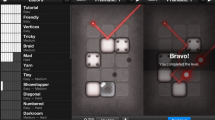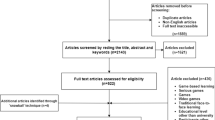Abstract
In this design-based research project, we investigated how and to what extent participating in architectural building and problem solving via a simulation game–based learning platform (called E-Rebuild) would facilitate mathematical practices of middle-school students in the informal learning setting. This study encompasses 2 iterative design experiments in which 20 middle graders completed E-Rebuild-based learning tasks as part of an afterschool program and a summer math camp. Data were collected via screen- and webcam-recorded participation actions and reactions, mathematical problem-solving test, and interviewing. Enriching prior research on math and science learning through making, this study informs how and under what contexts mathematical practices and disposition emerge during the making-centered learning processes.


Similar content being viewed by others
Notes
All participants’ names in this paper are pseudonyms.
Two participants missed the pretest and their data were not included in the paired-sample t-tests.
References
Ackermann, E. (2001). Piaget’s constructivism, Papert’s constructionism: What’s the difference. Future of Learning Group Publication, 5(3), 438–449.
Bagley, E. & Shaffer, D. W. (2010). The epistemography of urban and regional planning: Appropriation in the face of resistance. In K. Gomez, L. Lyons, & J. Radinsky (Eds.), Proceedings of the 9th international conference of the learning sciences (Vol. 1, pp. 81–88). Chicago, IL: International Society of the Learning Sciences.
Dewey, J. (1910). Science as subject-matter and as method. Science, 31, 121–127.
Dewey, J. (1997). How we think. Mineola, NY: Dover Publications.
Dougherty, D. (2013). The maker mindset. In M. Honey & D. E. Kanter (Eds.), Design. Make. Play. Growing the next generation of STEM innovators (pp. 7–16). New York, NY: Routledge.
Eriksson, I., & Lindberg, V. (2016). Enriching ‘learning activity’ with ‘epistemic practices’–enhancing students’ epistemic agency and authority. Nordic Journal of Studies in Educational Policy, 2016(1), 32432.
Harel, I. E. & Papert, S. E. (1991). Constructionism. Westport, CT: Ablex Publishing.
Halverson, E. R., & Sheridan, K. (2014). The maker movement in education. Harvard Educational Review, 84(4), 495–504.
Hira, A., Joslyn, C. H. & Hynes, M. M. (2014). Classroom makerspaces: Identifying the opportunities and challenges. In 2014 IEEE Frontiers in Education Conference (FIE) Proceedings (pp. 1677–1681). Madrid, Spain: IEEE.
Kafai, Y. (1995). Minds in play: Computer game design as a context for children’s learning. Mahwah, NJ: Lawrence Erlbaum.
Kafai, Y. B. & Resnick, M. (2012). Introduction. In Y. Kafai, & M. Resnick (Eds.), Constructionism in practice: Designing, thinking, and learning in a digital world (pp. 13–20). New York, NY: Routledge.
Kaput, J. J. (1994). The representational roles of technology in connecting mathematics with authentic experience. In R. Biehler, R. W. Scholz, R. Strässer, & B. Windelmann (Eds.), Didactics of mathematics as a scientific discipline (pp. 379–397). Dordrecht, Netherlands: Kluwer Academic Publishers.
Ke, F. (2013). Computer-game-based tutoring of mathematics. Computers & Education, 60(1), 448-457.
Ke, F. (2017). Designing intrinsic integration of learning and gaming actions in a 3D architecture game. In R. Zheng, & M. Gardner (Eds.), Handbook of research on serious games for educational applications (pp. 234-252). Hershey, PA: IGI Global.
Kebritchi, M., Hirumi, A., & Bai, H. (2010). The effects of modern mathematics computer games on mathematics achievement and class motivation. Computers & Education, 55(2), 427–443.
Kolodner, J. L., Camp, P. J., Crismond, D., Fasse, B., Gray, J., Holbrook, J., . . . Ryan, M. (2003). Problem-based learning meets case-based reasoning in the middle school science classroom: Putting learning by design into practice. Journal of the Learning Sciences, 12(4), 495–547.
Lee, C. Y., & Chen, M. P. (2009). A computer game as a context for non-routine mathematical problem solving: The effects of type of question prompt and level of prior knowledge. Computers & Education, 52(3), 530–542.
Martin, L. (2015). The promise of the maker movement for education. Journal of Pre-College Engineering Education Research (J-PEER), 5(1), 30–39.
Martinez, S. L., & Stager, G. (2013). Invent to learn: Making, tinkering, and engineering in the classroom. Torrance, CA: Constructing modern knowledge press.
Niemeyer, D. J., & Gerber, H. R. (2015). Maker culture and Minecraft: Implications for the future of learning. Educational Media International, 52(3), 216–226.
Papavlasopoulou, S., Giannakos, M. N., & Jaccheri, L. (2017). Empirical studies on the maker movement, a promising approach to learning: A literature review. Entertainment Computing, 18, 57–78.
Peppler, K., Halverson, E. & Kafai, Y. B. (Eds.). (2016). Makeology: Makerspaces as learning environments (Vol. 1). New York, NY: Routledge.
Piaget, J. (1951). Play, dreams and imitation in childhood. New York, NY: W. W. Norton & Company.
Quinn, H., & Bell, P. (2013). How designing, making, and playing relate to the learning goals of K-12 science education. In M. Honey & D. E. Kanter (Eds.), Design, make, play: Growing the next generation of STEM innovators (pp. 17–33). New York, NY: Routledge.
Shaffer, D. W. (2005). Epistemic games. Innovate: Journal of Online Education, 1(6), 2. Retrieved Apr. 2012, from https://nsuworks.nova.edu/innovate/vol1/iss6/2. Accessed April 2012
Shute, V. J., Ventura, M. & Ke, F. (2015). The power of play: The effects of Portal 2 and Lumosity on cognitive and noncognitive skills. Computers & Education, 80, 58-67.
Svarovsky, M. G. N. (2009). Unpacking the digital zoo: An analysis of the learning processes within an engineering epistemic game (Unpublished doctoral dissertation). Madison, WI: University of Wisconsin.
Tuminaro, J., & Redish, E. F. (2007). Elements of a cognitive model of physics problem solving: Epistemic games. Physical Review Special Topics-Physics Education Research, 3(2), 1–22.
Van den Heuvel-Panhuizen, M. (2003). The didactical use of models in realistic mathematics education: An example from a longitudinal trajectory on percentage. Educational Studies in Mathematics, 54(1), 9–35.
Funding
This project is funded by the National Science Foundation, grant# 1318784. Any opinions, findings, and conclusions or recommendations expressed in these materials are those of the author(s) and do not necessarily reflect the views of the National Science Foundation.
Author information
Authors and Affiliations
Corresponding author
Electronic supplementary material
ESM 1
(DOCX 250 kb)
Rights and permissions
About this article
Cite this article
Ke, F., M. Clark, K. & Uysal, S. Architecture Game-Based Mathematical Learning by Making. Int J of Sci and Math Educ 17 (Suppl 1), 167–184 (2019). https://doi.org/10.1007/s10763-019-09996-x
Received:
Accepted:
Published:
Issue Date:
DOI: https://doi.org/10.1007/s10763-019-09996-x




